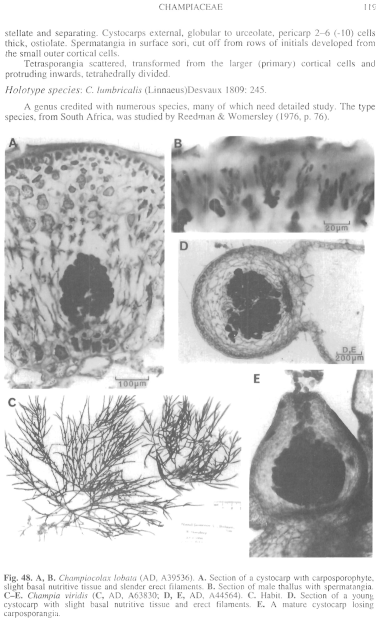|
|
|
|
|
|||||||||||
|
Electronic Flora of South Australia Species Fact Sheet
Phylum Rhodophyta – Class Florideophyceae – Order Rhodymeniales – Family Champiaceae
Thallus (Fig. 47A) 2–4 mm high, erect and branched, forming dense clumps with terete, segmented, stubby branches 0.5–1 mm in diameter, arising from a solid stipitate base (Fig. 47C), hemiparasitic on Champia viridis. Structure multiaxial with a solid, pseudoparenchymatous base attached to the host Champia by rhizoidal filaments (Fig. 47D, E), producing above segmented branches (Fig. 47B, C) with a cluster of apical cells, developing a cortex 1–2 cells thick, outer cells anticlinally elongate and 6–12 µm in diameter, with 2–6 monostromatic diaphragms (Fig. 47C) and longitudinal filaments, bearing odd secretory cells, scattered throughout the diaphragms. Rhodoplasts discoid, few in outer cells.
Reproduction: Gametangial thalli monoecious, sexual structures originating on pseudoparenchymatous tissue. Carpogonial branches unknown, auxiliary cell branches probably 2-celled. Carposporophytes (Fig. 48A) with a small basal fusion cell and all cells forming carposporangia 15–25 µm in diameter. Basal nutritive tissue very slight (Fig. 48A), erect filaments present around the carposporophyte. Cystocarps globular, largely external, 700–1000 µm in diameter, pericarp 4–8 cells and 150–300 µm thick, with a narrow ostiole. Spermatangia (Fig. 48B) in small sod, cut off from initials on outer cortical cells, ovoid, 2–3 µm in diameter.
Tetrasporangia unknown.
Type from Warrnambool, Vic., on Champia viridis, drift (Womersley, 1.ix.1971); holotype in AD, A39536.
Distribution: Stenhouse Bay, S. Aust., to Warrnambool, Vic., all on Champia viridis.
Taxonomic notes: C. lobata differs from the type species in its pseudoparenchymatous base and larger, more lobed, thallus; the type is also reported as non-ostiolate. However further studies are needed on details of thallus structure and reproduction. Kraft & Woelkerling (1981, fig. 4.8H; 1990, fig. 3.9H) figured C. lobata as a "dwarf plant" on a species of Champia. The Stenhouse Bay specimen occurs on cystocarpic Champia.
References:
KRAFT, G.T. & WOELKERLING, W.J. (1981). Rhodophyta — systematics and biology. In Clayton, M.N. & King, R.J. (Eds), Marine Botany: an Australasian Perspective, Ch. 5, pp. 104–137. (Longman Cheshire: Melbourne.)
KRAFT, G.T. & WOELKERLING, W.J. (1990). Rhodophyta. In Clayton, M.N. & King, R.J. (Eds), Biology of Marine Plants, Ch. 3, pp. 41–85. (Longman Cheshire: Melbourne.)
The Marine Benthic Flora of Southern Australia Part IIIB complete list of references.
Publication:
Womersley, H.B.S. (28 June, 1996)
The Marine Benthic Flora of Southern Australia
Rhodophyta. Part IIIB. Gracilarialse, Rhodymeniales, Corallinales and Bonnemaisoniales
Reproduced with permission from The Marine Benthic Flora of Southern Australia Part IIIB 1996, by H.B.S. Womersley. Australian Biological Resources Study, Canberra. Copyright Commonwealth of Australia.
Illustrations in Womersley Part IIIA, 1996: FIGS 47, 48A, B.

Figure 47 enlarge
Fig. 47. Champiocolax lobata (AD, A39536). A. Habit, lowest lobe with septa. B. Lobe with septa. C. Longitudinal section of lobe with septa and pseudoparenchymatous base. D. Attachment to Champia (rows of large cells). E. Attachment of older thallus to Champia (at base of section).

Figure 48 enlarge
Fig. 48. A, B. Champiocolax lobata (AD, A39536). A. Section of a cystocarp with carposporophyte, slight basal nutritive tissue and slender erect filaments. B. Section of male thallus with spermatangia. C–E. Champia viridis (C, AD, A63830; D, E, AD, A44564). C. Habit. D. Section of a young cystocarp with slight basal nutritive tissue and erect filaments. E. A mature cystocarp losing carposporangia.

|
Email Contact: State Herbarium of South Australia |

|